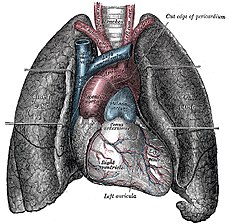Exercise as it relates to Disease/Thwarting Pulmonary Embolism with Exercise
What is Pulmonary Embolism?
[edit | edit source]Pulmonary Embolism (PE) is a blockage of the lungs pulmonary artery due to a foreign body that has traveled though the blood stream from elsewhere in the body.
The main cause of PE is Deep Vein Thrombosis (DVT) which is the formation of a blot clot in the leg.

PE most commonly affects people whom have pre-existing medical conditions, are inactive or have had surgery. Anyone at almost any age can be affected by PE, Fortunately many of the major risk factors of PE can be reduced with exercise.[1]
Major Causes of Pulmonary Embolism
[edit | edit source]The following is a list of the biggest risk factors for PE:[2]
Prior medical history-
- Heart Disease: High blood pressure and cardiovascular diseases increase the likelihood of developing blood clots.
- Cancer: Specific types of cancer and chemotherapy both carry the risk of increasing blood clotting.
- Family History of Blood clots & Embolism: If other blood relations have had blood clots or embolism it is possible that there are inherited family traits that lead to an increased likelihood of PE.
Sedentary behavior-
- Bed rest: People whom are confined to bed after undergoing a operation, injuring or any other conditions that require them to lay down for extended periods in order to recover. The risk associated with this is that if a persons lower extremities are horizontal for to long the venous blood begins to slow, thus increasing the risk of clotting.
- Traveling: Any situation where a person is required to sit in a position where they are unable to stretch increases the chance of clots forming.
Surgery-
- Immobilisation: Just laying horizontally and immobile for extended periods can cause a clot, the risks are only further increased for every minute spent under anesthesia.
Other factors that may contribute to developing PE include: Obesity, smoking, birth control or pregnancy.
Protecting yourself from Pulmonary Embolism
[edit | edit source]The biggest cause of PE is when a persons blood stops moving which gives it a chance to clot, therefore the most effective solution is to get the blood moving!
Once a person has been diagnosed with PE Immediate medical attention and medication is required (see PE treatment & management), however there are steps that can be taken to greatly reduce the risk of developing PE.

Stay active. Blood starts to pool when you stop moving such as during a long car trip or a flight the following are some examples of what you can do to get that blood pumping again.[3]
- For every two hours of travel get up and go for a short walk (up the plane isle or on the side of the road).
- Perform calf stretches whilst sitting down (alternate between lifting heels and toes).
- If you have enough room lift and straighten your legs (alternate between them)
If you are required to remain in bed there are still a number of stretches that can be performed on your back.[3]
- While lying down bring one knee to your chest using your hands to pull it gently towards you and hold for 10 seconds, keep the other leg straight and alternate between them.
- Calf stretches, with your legs straight point your toes as far away from you as possible and hold for 10 seconds, then draw them up as far as you can towards you, repeat this three times.
References
[edit | edit source]- ↑ Dalen, James E; Alpert, Joseph S (1975). "Natural history of pulmonary embolism". Progress in Cardiovascular Diseases. 17 (4): 259–70. doi:10.1016/S0033-0620(75)80017-X. PMID 1089991.
- ↑ Staff, M. (2014). Pulmonary Embolism. [online] Mayo Clinic. Available at: http://www.mayoclinic.org/diseases-conditions/pulmonary-embolism/basics/risk-factors/con-20022849 [Accessed 27 Sep. 2014].
- ↑ a b Suszynski, M. (2014). Long Flight? Bed Rest? Easy Exercises Prevent Blood Clots. [online] EverydayHealth.com. Available at: http://www.everydayhealth.com/news/long-flight-bed-rest-easy-exercises-prevent-blood-clots/ [Accessed 30 Sep. 2014].
Further Reading / Additional Resources
[edit | edit source]- Pulmonary embolism and DVT [1]